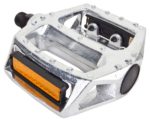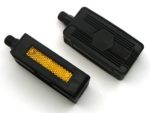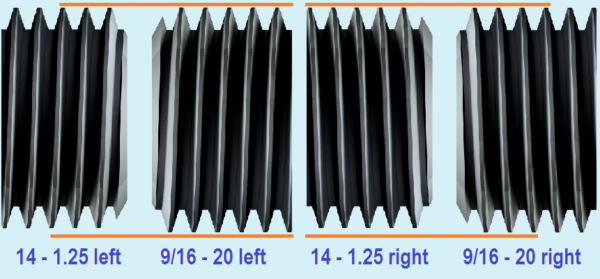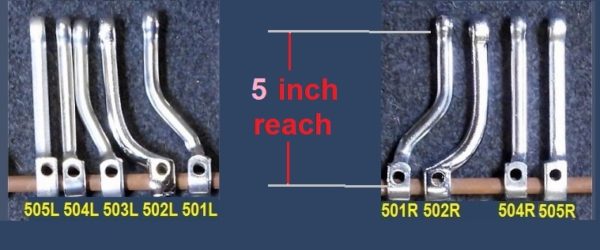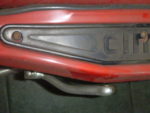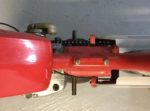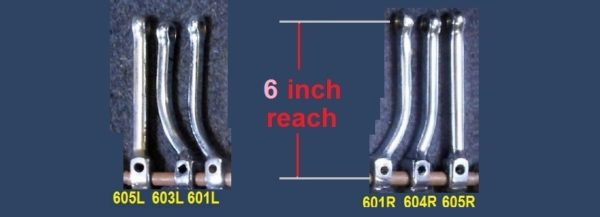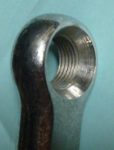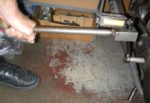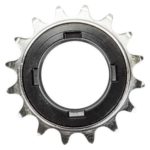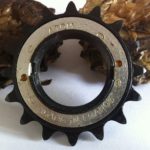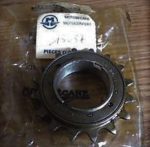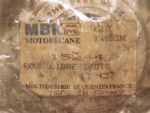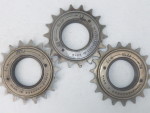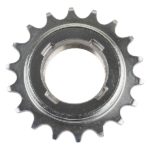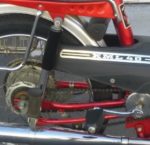Contents: 1 Pedals 2 Pedal Cranks (Arms) 3 Pedal Pins 4 Pedal Shafts
Contents: 5 Pedal Freewheels 6 Pedal Chains 7 Pedal Chain Tensioners
Contents: 8 Pedal Shaft Bushings
1 P E D A L S
These are new pedal sets, right and left, size 9/16″. The thread is 9/16 – 20. They fit all mopeds except Motobecane, Peugeot, and Derbi, and other French or Spanish-made mopeds, such as the Spanish-made Puch Magnum.
Pedal threads: Most bicycle pedals have either 1/2-20 or 9/16-20 threads. But some vintage bicycles use “French thread” pedals, which is metric 14 – 1.25. The 14.0 mm thread is slightly smaller than 9/16″ (14.3 mm), but bigger than 1/2″ (12.7mm).
14mm pedals screw into 9/16 cranks all the way but fit loosely. Then later they break off or strip out easier.
9/16 pedals screw into 14mm cranks so tight they stop half way. Then later they break off or strip out easier.
2 P E D A L C R A N K S
Left and Right: With shoes it’s easy to tell if they’re on the wrong feet. But with moped cranks it is not. A left crank and pedal looks and functions the same as a right. So it is possible for a moped to have both left pedals and cranks, or both right, or the right on the left side and the left on the right side. Then when, say the left side pedal is missing, it might actually need a right, or visa versa.
 Righty Tighty: This rule says “Viewed from above the bolt head, turning to the right, clockwise, is tightening”. Almost all bolts and nuts obey this rule because they are right hand thread. But left hand threads are opposite. They obey the opposite rule, “Lefty Tighty”.
Righty Tighty: This rule says “Viewed from above the bolt head, turning to the right, clockwise, is tightening”. Almost all bolts and nuts obey this rule because they are right hand thread. But left hand threads are opposite. They obey the opposite rule, “Lefty Tighty”.
How to tell: It is sometimes not easy to tell if a pedal or a crank is left or right. Most modern bicycle pedals are stamped L or R. Most modern reproduction cranks are also stamped L or R. Most vintage European right cranks are stamped D (droit, destra, desno, derecho) or R (recht, right). Some vintage European left cranks are not marked, and some are stamped S (sinestra) or G (gauche) or L (levo, left).
Another way to tell is by viewing the threads directly. When a right thread bolt is held with the tail facing up, each thread slopes upward going from left to right. When a left thread bolt is viewed the same way, the threads slope in the opposite direction. With crank threads, right thread goes inward clockwise, left thread goes outward clockwise. You have to follow the first thread around in a circle with your eyes.
How not to strip threads: Know which way to turn, and use lubricant. Know how it should feel. Know how tight it should be. And know how to use taps or dies or thread files to “clean up” damaged threads, before they fail completely.
Pedal Crank Arms for Sale
All of these have a 16mm pedal shaft hole
Lengths are in inches, green price is new, dark green price is used
# reach length offset style pin thread L/R price original on description markings
431L 4¾ 5¾ 1.50 2 9.0 9/16-20 L none Minarelli left (Sinistra) says S
431R 4¾ 5¾ 1.50 2 9.0 9/16-20 R none Minarelli right (Destra) says D
432L 4¾ 5¾ 1.75 2 9.0 9/16-20 L $25.0 short high-offset left (Sinistra) S
433L 4¾ 5¾ 1.00 3 note 9/16-20 L $19.0 Minarelli or Morini replica left L
433R 4¾ 5¾ 1.00 3 note 9/16-20 R $23.0 Minarelli or Morini replica right R
434L 4¾ 5¾ 1.25 3 9.5 9/16-20 L none Morini MO1, MO2 left S use 502L
434R 4¾ 5¾ 1.25 3 9.5 9/16-20 R none Morini MO1, MO2 right D use 502R
435R 4¾ 5¾ 0.75 5 9.0 9/16-20 R none Minarelli V1 right (Destra) says D
436L 4¾ 5¾ 0.85 6 9.0 9/16-20 L 20-30 Vespa Ciao left (Sinistra) says S
433 = 433L & 433R 2 9.0 9/16-20 set $36.0 beautiful chrome shorty repro set
433 = 433L & 433R 2 note 9/16-20 set $35.0 shiny black shorty repro set
note: The 433 pedal arms require a 9mm pin and grinding of the shaft hole 1 mm bigger.
On these the grinding has been performed and is included in the price.
Shown here are the 3-style vintage Italian original pedal cranks on Italian (mostly) mopeds with Morini MO1, MO2, M1 engines. These cranks need to be the 3 style, that “goes outward right away”, because the engine sticks out close to the pedal shaft.
Besides clearing the engine when the crank is horizontal, sometimes this style crank is needed to clear the covers above the engine, when the crank is vertical.
# reach length offset style pin thread L/R price original on description markings
501R 5 6 1.25 2 9.5 9/16-20 R $15.00 Batavus M48 right (Recht) says R
501L 5 6 1.25 2 9.5 9/16-20 L $28.00 Batavus M48 left (Links) says L
502R 5 6 1.25 3 9.5 9/16-20 R none Sachs 505 replica right (Recht) R
502L 5 6 1.50 3 9.5 9/16-20 L $20.0 Sachs 505 replica left (Links) L
503R 5 6 0.75 5 9.5 9/16-20 R N/A Cimatti (Minarelli) right (Recht) R
503L 5 6 0.75 5 9.5 9/16-20 L $20.00 Cimatti (Minarelli) left (Links) L
504R 5 5¾ 0.00 7 9.5 9/16-20 R $25.0 Trac M56 straight rough says R
504L 5 5¾ 0.00 7 9.5 9/16-20 L $25.0 Trac M56 straight rough says L
505R 5 5¾ 0.00 7 9.5 9/16-20 R N/A Batavus M56 straight smooth R
505L 5 5¾ 0.00 7 9.5 9/16-20 L $17.0 Batavus M56 straight smooth L
502 = 502L & 502R 3 note 9/16-20 set $33.00 3-style chrome rough-back set
note: 502 arms require a 9.0 pin with the flat part ground 1 mm lower. Price $7 each.
Left , comparison of 603L and 604R Garelli originals with 502L and 502R replacement arms, 3/4″ shorter.
Garelli Gulp requires pedal arms that go outward early, with a high offset. Here is the #502 pedal arm set that fits but the arms are one inch shorter.
These 502 pedal arms have 9.5 mm pin holes, but the holes are 1 mm closer to the pedal shaft, so they need 9.0 pins ground 1 mm thinner on the flat side.
# reach length offset style pin thread L/R price original on description markings
510R 5¼ 6½ 1.50 2 9.5 9/16-20 R $21.00 replacement chrome right says R
510L 5¼ 6½ 1.50 2 9.5 9/16-20 L $19.00 replacement chrome left says L
511R 5¼ 6¼ 1.25 2 9.5 9/16-20 R N/A Sparta Foxi right (Recht) says R
511L 5¼ 6¼ 1.25 2 9.5 9/16-20 L $25.00 Sparta Foxi left (Links) says L
512R 5¼ 6¼ 1.25 3 9.5 9/16-20 R $25.00 Hercules-Sachs 505 (Recht) R
512L 5¼ 6¼ 1.25 3 9.5 9/16-20 L N/A Hercules-Sachs 505 left (Links) L
513R 5¼ 6¼ 0.75 4 9.0 9/16-20 R $19.00 Tomos A35, A55, chrome repro R
513L 5¼ 6¼ 0.75 4 9.0 9/16-20 L $19.00 Tomos A35, A55, chrome repro L
514R 5¼ 6¼ 0.75 4 9.5 9/16-20 R $17.00 Tomos A35, A55, black replica R
514L 5¼ 6¼ 0.75 4 9.5 9/16-20 L $17.00 Tomos A35, A55, black replica L
515R 5¼ 6 1.00 5 9.0 14-1.25 R N/A Peugeot 102 right (Droite) says D
515L 5¼ 6 1.25 5 9.0 14-1.25 L $15-20 Peugeot 102 left (Gauche) says G
516R 5¼ 6 0.85 6 9.0 9/16-20 R $12-18 Vespa Grande, Si right (Destra) D
516L 5¼ 6 0.75 6 9.0 9/16-20 L $20-30 Vespa Grande, Si lf. says nothing
517R 5¼ 6 0.50 6 9.5 9/16-20 R N/A pre-1987 Tomos A3 (Desno) D
517L 5¼ 6 0.50 6 9.5 9/16-20 L N/A pre-1987 Tomos A3 left (Levo) L
518R 5¼ 6 0.00 7 9.5 9/16-20 R $20.00 1970-95 Jawa rt. (Pravo) says P
518L 5¼ 6 0.00 7 9.5 9/16-20 L $20.00 1970-95 Jawa left (Vlavo) says L
513 = 513L & 513R 4 9.0 9/16-20 set $35.0 Tomos repro beautiful chrome set
514 = 514L & 514R 4 9.0 9/16-20 set $33.00 Tomos repro black coated set
Note: 513 and 514 arms have 9.5 mm pin holes but require 9.0 mm wedge pins.
Shown here are the M3-style vintage German original pedal cranks on Hercules mopeds with Sachs 505 engine, such as the US-model “Sachs Balboa”. On a Taiwan moped with a Sachs 505 engine, such as “General 5-Star ST”, the pedal cranks are Taiwan made compatibles, that look different but have about the same dimensions and same style.
These “go outward right away”, not to clear the engine, but to clear the covers above the engine, when the crank is vertical.
Shown here are the 4-style modern Slovenian original pedal cranks on 1986 and later Tomos mopeds, from late A3 to A35 and A55 engine models. Here the 2009 Tomos A55 engine pedal shaft is much longer than it needs to be, by 3/4″ on the left, and 1 3/4″ on the right, as you can see.
Back in the day, moped engines (and people) were thinner. The early 1974-79 early A3 pedal cranks did not have or need much offset, as shown at right.
# reach length offset style pin thread L/R price original on description markings
521R 5½ 6½ 1.00 4 9.0 14-1.25 R 22-15 Motobecane right (Droit) D 40
521L 5½ 6½ 1.00 4 9.0 14-1.25 L $45.0 Motobecane left (Gauche) G 40
522R 5½ 6½ 1.00 4 9.0 9/16-20 R 32-25 Motobecane rt. re-threaded D 40
522L 5½ 6½ 1.00 4 9.0 9/16-20 L 55-45 Motobecane lf. re-threaded G 40
523L 5½ 6½ 1.25 4 9.0 14-1.25 L $50.0 MB left, 1/4″ extra offset G 40
524L 5½ 6½ 0.00 7 9.5 9/16-20 L $15.0 unidentified vintage European L
521 = 521L & 521R 4 9.0 14-1.25 set $60.0 Motobecane original-thread set
522 = 522L & 522R 4 9.0 9/16-20 set $90.0 Motobecane orig. re-threaded set
Shown here are the 4-style vintage French original pedal cranks on Motobecane Mobylette mopeds 1972-1980+. On variator models, like 50V, the engine swings back as the bike speeds up. The clutch wheel often scrapes against the left pedal crank. On non-variator (Dimoby) models, like 50 or 40, the engine does not swing back as the bike speeds up (but it does swing to keep the belt tight). On those models there is also 3/8 inch more space between the clutch wheel and the pedal crank. So they “never” scrape.
# reach length offset style pin thread L/R price original on description markings
531R 5¾ 6¾ 1.25 2 9.0 14-1.25 R $12-20 Peugeot 103 right (Droit) V.P. D
532R 5¾ 6¾ 1.25 2 9.0 9/16-20 R $22-30 Peugeot 103 rt re-threaded V.P. D
533R 5¾ 6¾ 1.50 4 9.5 9/16-20 R N/A Columbia-Solo rt. (Recht) says R
533L 5¾ 6¾ 1.50 4 9.5 9/16-20 L N/A Col.-Solo lf. (Links) says nothing
534L 5¾ 6¾ 1.25 5 9.0 14-1.25 L $20-30 Peugeot 103 left says nothing
535L 5¾ 6¾ 1.50 2 9.0 14-1.25 L N/A French replica left (Gauche) G
535R 5¾ 6¾ 1.50 2 9.0 14-1.25 R N/A French replica right (Droite) D
536R 5¾ 6¾ 0.75 6 9.0 9/16-20 R $24.00 pre-77 Garelli w/groove right D
536L 5½ 6½ 1.50 6 9.0 9/16-20 L N/A pre-77 Gar w/groove says nothing
537R 5½ 6½ 1.50 3 9.5 9/16-20 R N/A Avanti (Garelli remake) rt. says R
537L 5¾ 6½ 1.50 3 9.5 9/16-20 L N/A Avanti (Garelli remake) lf. says L
538R 5¾ 6½ 0.80 6 9.5 9/16-20 R N/A Kreidler MP9 right (Recht) says R
538L 5¾ 6½ 0.80 6 9.5 9/16-20 L $18.0 Kreidler MP9 left (Links) says L
539R 5¾ 6¾ 1.25 3 9.0 9/16-20 R $22.00 Garelli Gulp rt. (Desdra) says D
531 = 534L & 531R 2&5 9.0 14-1.25 set $40.00 Peugeot 103 orig. 2 & 5-style set
Here is a 2-style vintage French right crank, on 1975-83 Peugeot 103 mopeds. The right arm has sharper bends than left, because the right cover is closer to the pedal arm. The left is a 5-style, with a more gentle bend.
# reach length offset style pin thread L/R price original on description markings
601R 6 7 1.25 3 9.0 14-1.25 R $29 Derbi Variant right (Derecho) D
601R 6 7 1.25 3 9.0 9/16-20 R $16 Derbi Variant right re-threaded D
601L 6 7 1.25 3 9.0 14-1.25 L $15-22 Derbi Variant left says nothing
603L 5¾ 6¾ 1.25 3 9.0 9/16-20 L N/A Garelli left (Sinistra) says nothing
604R 6 6¾ 0.75 6 9.0 9/16-20 R $18-23 Garelli right (Destra) says D
605R 6 6¾ 0.00 7 9.5 9/16-20 R $17-22 KTM Foxi right (Recht) says R
605L 6 6¾ 0.00 7 9.5 9/16-20 L $15-20 KTM Foxi left (Links) says L
Here are vintage Italian 6-style right and 3-style left crank arms for 1977-83 Garelli Gulp, VIP, and maybe Monza. The left has more offset than the right. It needs the 3 style that “goes outward right away” because the left side of the engine sticks out near the pedal shaft.
Shown at left are L3-style vintage Spanish crank arms for 1975-1986 Derbi Variant.
Shown at right are higher offset 3-style Spanish arms for 1986-89 Derbi Variant Sport.
Like Tomos and Garelli the later engines were wider.
# reach length offset style pin thread L/R price original on description markings
611R 6¼ 7½ 1.50 0 9.5 9/16-20 R $20-35 Puch 2-spd right (Recht) says R
611L 6¼ 7½ 1.50 0 9.5 9/16-20 L N/A Puch 2-s left (Links) says nothing
612R 6¼ 7½ 1.30 1 9.5 9/16-20 R $20-25 Puch Maxi right (Recht) says R
612L 6¼ 7½ 1.30 1 9.5 9/16-20 L $20-30 Puch Maxi lf. (Links) says nothing
613R 6¼ 7½ 2.00 0 9.5 9/16-20 R $12.0 Puch Maxi replica raw-gray says R
613L 6¼ 7½ 2.00 0 9.5 9/16-20 L $17.0 Puch Maxi replica raw-gray says L
613 = 613L & 613R 0 9.5 9/16-20 set $28.0 Puch replica gray un-plated set
614R 6¼ 7½ 2.00 0 9.5 9/16-20 R $13-00 Puch Maxi replica chrome says R
614L 6¼ 7½ 2.00 0 9.5 9/16-20 L $18-00 Puch Maxi replica chrome says L
614 = 614L & 614R 0 9.5 9/16-20 set $33-00 Puch replica beautiful chrome set
no. reach length offset style pin thread L/R price original on description markings
621L 6½ 7¼ 0.00 7 9.5 9/16-20 L $7-$10 1970’s 10-speed bicycle left
Shown here are the 0-style vintage Austrian cranks on 1978-86 Puch Maxi and Magnum models. There are also 1-style Puch cranks, on 1968-78 Puch Maxi. Those are the same dimensions except the bend is more sharp.
What were they thinking? Pedal cranks for Puch mopeds have about 1/3 of the threads removed by machining. This makes them get stripped easier. The only plausible explanation is Puch was thinking about safety. When a rider forgets where the pedals are, and leans over in a turn, one pedal can hit the ground. If it hits hard enough it can cause a crash. Puch pedals are designed to break away, rather than causing a crash.
Pedal Crank Selection:
Offset: Ideally the pedal arms should have enough offset to not hit anything, even after being bent inward a little, yet not have too much offset. Too much offset causes the pedals to hit the ground sooner when leaned over, and to stick out more when parking or storing, and to hit the riders feet more when backing up.
Length: Longer pedal arms provide more leverage. For mopeds the pedals are mainly used for starting the engine, rather than pedaling. So if the engine turns over easily then long pedal arms are not needed. Longer arms hit the ground sooner when leaned over. And when not pedaling, one foot is more forward and the other is more back. So shorter arms are better, in many ways. But for pedaling, longer arms are better, especially for riders with long legs.
Style: Some engines or bikes need cranks that “go outward right away” because something is sticking out near the pedal shaft. This is the style 3 above. Sachs 505, Morini MO1, MO2 and Garelli VIP engines are some common examples.
Pedal Crank Service:
Straightening: 1. With a special tool like the one shown, and two people, a bent pedal crank can be straightened in one minute without any removal. The second person has to pull on the bike the opposite way, by standing hard on the opposite pedal. 2. Without that tool, the pedal only is removed and a long pipe that fits closely over the crank is used to apply torque. 3. For more stubborn cranks, the crank is removed and placed in a large bench vise. Again the pipe is placed over the crank at the right place, and torque is applied. Moped cranks require 100 to maybe 600 foot-pounds of torque to bend. This is done without heating.
Re-threading: Often just the first few threads become messed up. Bicycle shops have pedal taps, size 9/16-20 Right and Left, that can repair partially-stripped threads on moped cranks. Hardware stores do not have those taps, instead they have 9/16-18, more coarse. So pedal taps are a bicycle-industry-only item.
Repairing pedal crank threads is done by starting the tap from the good side, which is the back. Sometimes crank removal is required, and sometimes it is optional. Cutting fluid, or at least oil, is applied. The tap is moved back and forth as it is screwed in (like 4 steps forward and 3 steps back), until it goes all the way through.
Rethreading a M14-1.25 crank to 9/16-20 (from 14.0 to 14.3mm) is more difficult. The plated steel is hard and tough. It takes longer and requires more force. The crank arm and tap get hot by the end of the 10-20 minute process.
3 P E D A L P I N S
These round pins have a flat wedge that fits tight against a slot in the shaft. They are pressed or hammered in and out. In the bicycle industry they are known as cotter pins. Here they are called crank pins or wedge pins.
pedal pin 9.5 mm $2,
pedal pin 9.0 mm $2 each.
special 9.0 x 6.5 $7 each. The flat is 1mm lower.
One Up One Down: This rule says that if one crank pin points up, then the other should point down. This makes the left and right crank arms parallel at 12 o’clock and 6 o’clock. When the pins are both up, the arms are at 12 o’clock and 5 o’clock, lopsided and awkward.
Special pins: The 502 aftermarket pedal arms require special wedge pins. The regular pin shown on the right is 9.0 x 7.2 thick. After grinding it becomes the special pin on the left, which is 9.0 x 6.5 thick, or 1.3 mm thinner. These pins are required for the 502R and 502L aftermarket pedal arms. Price $8 each
4 P E D A L S H A F T S
Some mopeds with external pedal shafts, and separate pedal and motor chains, have one of the crank arms permanently attached to the shaft and sprocket. With those, to get a new sprocket-side arm you have to replace the shaft-with-arm.
Some mopeds with external pedal shafts, and separate pedal and motor chains, have no crank arms permanently attached to the shaft and sprocket. With those the sprocket-side arm can be replaced.
More on this parts topic, later…
5 F R E E W H E E L S
 Some mopeds have one drive chain and some have two. Two-chain mopeds, with both a motor chain and a pedal chain, have freewheels, like most bicycles. The freewheel is the rear pedal sprocket that spins free and goes “click click click” in the reverse direction, but locks up solid in the forward direction. The freewheel allows the pedals to be stationary even when the rear wheel is moving forward. The moped brands with right-side freewheels are Puch, Peugeot, Motobecane, Batavus, Sparta (Foxi), Hercules (Sachs), Piaggio (Vespa), Honda (PA50), Kreidler, KTM (Foxi), Kynast, Flandria. There are two brands with left-side backward freewheels, Jawa and Benelli. All of the other moped brands do not have external freewheels, but instead have a freewheel mechanism inside the engine unit.
Some mopeds have one drive chain and some have two. Two-chain mopeds, with both a motor chain and a pedal chain, have freewheels, like most bicycles. The freewheel is the rear pedal sprocket that spins free and goes “click click click” in the reverse direction, but locks up solid in the forward direction. The freewheel allows the pedals to be stationary even when the rear wheel is moving forward. The moped brands with right-side freewheels are Puch, Peugeot, Motobecane, Batavus, Sparta (Foxi), Hercules (Sachs), Piaggio (Vespa), Honda (PA50), Kreidler, KTM (Foxi), Kynast, Flandria. There are two brands with left-side backward freewheels, Jawa and Benelli. All of the other moped brands do not have external freewheels, but instead have a freewheel mechanism inside the engine unit.
The freewheel screws on and tightens with pedaling. Once it is tight, a special tool is required to remove it. The tool fits into slots in the freewheel center. Some low-end modern single-speed bicycle freewheels do not have removal slots. Those cheap kinds can be removed by destroying the freewheel. To remove a freewheel destructively without a removal tool, the freewheel is first disassembled, where all the little balls and clickers fall out, and then the inner hub is unscrewed in a bench vise or with a pipe wrench.
Most freewheels go on the right side of the bike and thus have right-hand thread, but Jawa and Benelli ones go on the left side of the bike and have left-hand thread.
Original and Replacement Freewheels
no. freewheel make country bike make part # teeth thread price original on
16a Dicta xxxxxxxx Taiwan xxx replacement 0000 16T 1.375″- 24 $12
16b The Best Wheel France xxxMotobecane 60483 16T 1.375″- 24 $25 Solex
16c Esjot xxxxxxx Germany Hercules 9000300401 16T 1.375″- 24 $30 Sachs Westlake (P1)
16d Atom xxxxxxxx France xxx Sparta 00. 055051 16T 1.375″- 24 $25 Sparta Foxi
16d Atom xxxxxxx France xxx Peugeot xxx39026 16T 1.375″- 24 $25 Peugeot (optional)
16d Atom xxxxxxxx France xxx Motobecane 16057 16T 1.375″-.24 $25 Motobecane 7
16e Ocean xxxxxxx Italy xxxxx Piaggio 000114531 16T 1.375″- 24 $25 Piaggio Ciao, Si early
18a Atom xxxxxxxx France xxx Peugeot 00017550 18T 1.375″- 24 N/A Peugeot 102, 103
18a Atom xxxxxxxx France xxx Batavus 00049020 18T 1.375″- 24 $30 1976-77 Batavus VA
18b The Best Wheel France xxxMotobecane 15244 18T M34.7-1.0 $50 70’s MB with MB hubs
18b J Moyne xxxxX France xxxMotobecane 15244 18T M34.7-1.0 $50 Wards Riverside (AV88)
18b The Best Wheel France xxxMotobecane 15244 18T M34.7-1.0 $50 50’s-60’s Motobecane
18c Ocean .xxxxxxx Italy .xxxx Piaggio 00 103631 18T 1.375″- 24 $25 Piaggio Bravo, Grande
18d Velo xxxxx Czechoslovakia Jawa xxxx070040 18T M35 -1 LH $35 1970-83 Jawa 28, 207
18e Sunlite xxxxxxx China x.xxxreplacement 0000 18T 1.375″- 24 $15
18f The Best Wheel France x.xxxreplacement 0000 18T M32 – 1.0 $13 unknown application
20a The Best Wheel France xxxMotobecane 14298 20T 1.375″- 24. N/A 70’s MB with Leleu hubs
20a The Best Wheel France xxxMotobecane 14298 20T 1.375″- 24. $20 1978-81 MB with mags
20b Atom xxxxxxx France xxx Batavus 00049019 20T 1.375″- 24 $30 Batavus HS50,Starflite
20b Atom xxxxxxx France xxx Peugeot 00000586 20T 1.375″- 24 $30 Peugeot (optional)
20c Esjot xxxxxxxx Germany x Kynast 00000586 20T 1.375″- 24 $22 Flying Dutchman
20e Sunlite xxxxxx China xxx xreplacement 0000 20T 1.375″- 24 $16
23a Atom .xxxxxxx France xxx Puch 3492410230 23T 1.375″- 24 $20-$30 Puch (all models)
Freewheel threads: Like with pedal threads there is a common size and an uncommon size slightly smaller.
The common size is 1.375″ – 24, which equals 34.92 – 1.06 mm. Most modern bicycles worldwide have this ISO (International Standards Organization) standard freewheel thread type.
The uncommon size is M34.7 – 1.00, which equals 34.70 – 1.00 mm. This “French” thread type is on vintage bicycles from France, Belgium, Spain or Switzerland, and on Motobecane mopeds with Motobecane-made hubs.
So the French freewheels are slightly smaller than the rest of the world, 34.7 instead of 34.9. That small amount does not matter as long as the bike is pedaled gently. But it does matter when the pedals are pushed very hard. Then the loose fitting threads on the wheel hub can strip out, a disaster.
It is difficult to tell which thread type a hub has, by measuring the thread tops with a calipers. The 34.92 thread hubs measure 34.65 to 34.7. The 34.70 hubs measure 34.55 to 34.6. On some hubs the tops of the threads are worn down and measure less. So a standard thread might seem like a French thread type. Because of this, it is better to put away the calipers and use “feel”.
When the freewheel and hub have the same thread type, the freewheel screws on easy, yet has no looseness. Looseness is felt with fingertips pulling and pushing the freewheel center side to side. When a 34.92 freewheel is on a 34.7 hub, the center of the freewheel can move 0.22 mm. Here is a video of that. That looseness or “wiggle” is felt. The same is true for any threaded thing. When a bolt fits a nut, it screws on easy and yet does not wiggle.
All of the freewheels in Myrons Mopeds inventory were measured by feel. For each bike model listed above, a sample rear wheel with original freewheel was measured directly by feel. The freewheel was removed. It’s threads were checked by screwing onto both a French and a standard hub. The wheel threads were checked by screwing on both a French and a standard freewheel.

Gauntlet of test wheels: MB 40, Batavus M48, Peugeot 103, Model 7 hub, MB 50, MB 50, MB 50VLA.
Not shown, Puch wheels and hubs, Sparta, Peugeot 102 hub, Kreidler, Sachs, KTM, Kynast, others.
Result: None of the hubs or freewheels had French thread, except Motobecanes with Motobecane-made hubs. Wow!

1970’s Puch & Motobecane 80mm hubs
L, Leleu-made Puch hub, standard thread
R, Motobecane-made hub, French thread
These are actual Motobecane rear wheels from Myrons inventory. All except one came from Los Angeles area bikes.
model xx rim x hub xx freewheel xxx teeth thread
40XXxxX thin MB xx none xxxxxxxx 18T French
40XXxxX thin MB xx none xxxxxxxx 18T French
50XXxxX wide MB xx none xxxxxxxx 18T French
50XXxxX wide MB xx none xxxxxxxx 18T French
50XXxxX wide MB xx The Best Wheel 18T French
Model 7X 16″ Leleu x none xxxx x xx xxx standard
50VXxxX wide Leleu x none xxxx x xx xxx standard
50VXxxX wide Leleu x The Best Wheel 20T standard
50VXXxx wide Leleu x The Best Wheel 20T standard
50VLAxx mag silver x The Best Wheel 20T standard
LeMoped mag gold xx none xxxxx xx xxx standard
LeMoped mag gold xx The Best Wheel 20T standard
Result: All Leleu-made hubs have standard freewheel thread 1.375″-24, even those for Motobecane. All Motobecane-made hubs have French thread M34.7-1.0. All Motobecane-made “6-star” mag wheels have standard thread, but it is tapered and begins with French thread, so that either type of freewheel can be used.
How to tell: The best way to tell if a 1970’s Motobecane moped rear hub is Motobecane-made (and therefore French thread) is visually. There is an prominent M logo on the freewheel side. There is no step on the freewheel side, instead it slopes gradually. The flanges go farther out from the spoke holes. So from 100 feet away, viewed from the side, the Motobecane-made hubs appear larger than Leleu-made hubs.
Summary
All two-chain rear hubs or wheels, on mopeds from the 1970’s and 80’s, have standard freewheel threads, except Motobecane-made hubs on 1950’s -60’s and some 1970’s Motobecane mopeds.
A standard thread freewheel fits a French thread hub and works fine when pedaled normally. Only when a strong athletic person pedals very hard, the hub threads can strip off, requiring wheel or hub replacement.
1950’s – 60’s Motobecane: Many models, maybe all, had French freewheel threads M34.7-1.0. In the 1960’s the parts manuals specified the thread. One example, shown at right, is for Motobecane AV88 and Motoconfort AU88. It lists the 18-tooth 15244 freewheel as having M34.7-100 thread.
The French freewheel thread cover up: It is very odd that, after 1976-77, Motobecane had two different freewheel threads, but they hid that fact. Instead they made the teeth different, 15244 (French thread) was 18 teeth, and the newer 14298 (standard thread) was 20 teeth. The Motobecane America parts manuals list both freewheels without explanation. There does not seem to be anything about freewheels in the Parts or Service Bulletins. The physical freewheels do not say the thread. The actual parts labels do not say the thread either. As a result, this cover-up has caused confusion and mystery for 39 years (1978-2017).
6 P E D A L C H A I N S
7 P E D A L C H A I N T E N S I O N E R S
8 P E D A L S H A F T B U S H I N G S
16.0 x 20.0 x 19.9 no lip $2.50 Tomos 200166, special bronze
16.2 x 20.1 x 19.0 w/ lip $5.00 Puch 349.142.0051, white plastic, for Maxi
16.2 x 21.0 x 15.9 w/ lip $5.00 Vespa 102875, black plastic, for Ciao
16.1 x 21.2 x 16.5 w/ lip $6.00 Batavus? , black plastic
16.1 x 21.3 x 18.7 w/ lip $5.00 Buzzetti 0168, black plastic, for Puch Magnum
16.2 x 25.6 x 15.5 w/ lip $5.00 Vespa 141737, black plastic, for Bravo, Grande, Si


